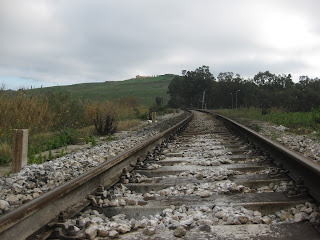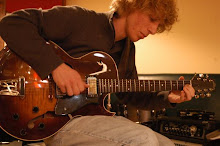It has seemed to many of us on the trip that each day either matched or exceeded the wonderful experiences of the previous one, and day three in Italy was no exception.
I did sleep better, and we got back aboard the bus at 9:00AM, heading this time in the direction of Corleone, the town made famous by The Godfather trilogy. It was the fictional birthplace of the movie's main character Vito Corleone, portrayed in two Oscar-winning performances by Marlon Brando and Robert De Niro. The subject of the day was the mafia, as we spent our time in the tiny town of 12000 people at the anti-mafia museum.
A statue in Piazza Falcone E Borsellino commemorating the fight against the mafia in Corleone
Walking through Corleone
The flags of (from left to right) Italy, Sicily, and the EU outside the Anti-Mafia Museum.
We had a really tremendous tour guide at the museum who'd lived for many years in Toronto, showing off a Canadian "oot" now and again in her Italian-litled English. She presented the museum's collection of photojournalism on the subject, exposing the underlying comments of each picture.
What I found particularly interesting in our discussion with her, and the noted Italian journalist afterwards, was how the history of the mafia is really just being written today. It is not a firm history as, for more than a century, people were intimidated into not talking about it. This code of silence is referred to as "omertà" There are so few written accounts from the past, so the story is still being formulated now. Even in the 1970's it was basically forbidden that journalists report on the mafia.
I had the opportunity to ask our guide if she could describe the origins of this phenomenon, as I'd been struggling for a while with multiple somewhat conflicting interpretations of the mafia's history—which makes sense now given the omertà. What the guide roughly described was that the mafia came out of the early 19th century society of big landowners and peasant farmers. The lands were essentially sharecropped, and the owners employed a group of people to oversee their holdings in person. This group eventually became the mafia. These middle men played against both sides of the structure, seizing a hold of the power over the agricultural market, Sicily's greatest export. Moving into the 20th century, they expanded their presence into the cities, extorting politicians and judges, while controlling most markets for vice on the island.
I had the opportunity to ask our guide if she could describe the origins of this phenomenon, as I'd been struggling for a while with multiple somewhat conflicting interpretations of the mafia's history—which makes sense now given the omertà. What the guide roughly described was that the mafia came out of the early 19th century society of big landowners and peasant farmers. The lands were essentially sharecropped, and the owners employed a group of people to oversee their holdings in person. This group eventually became the mafia. These middle men played against both sides of the structure, seizing a hold of the power over the agricultural market, Sicily's greatest export. Moving into the 20th century, they expanded their presence into the cities, extorting politicians and judges, while controlling most markets for vice on the island.
Hinting at another version of the story I've heard, our guide did say she believed the mafia's origins may have stemmed from farther back in the island's history. As Sicily fell under so many different empires through the centuries, some believe the locals put their own government together to maintain some constancy between regimes. This, at least in spirit, may have evolved into the mafia.
There do appear to be real holes in the history, at least in terms of how it's agreed upon by various scholars, but it seems that few people have taken the time to study the mafia until now. The history we may come to know is still being shaped, as they slowly try to reach some truth. That is, if there is any truth to be reached.
We often say that the winners write history, and in this case, it seems the winners were the mafia, and they chose not to write anything. Who knows if we'll ever find out the answers to our questions this phenomenon.
The complete records from the Maxi trial (above) are housed at the museum. The trial, prosecuted by Giovanni Falcone and Paolo Borselino in the mid 1980s famously convicted 360 out of 474 mafia defendants, who were handed a combined 2,665 years of prison time and 19 life sentences (there is no death penalty in Italy.) Both Falcone and Borselino were killed in the early 1990s in mafia-related incidents. They are hailed as heroes today across Italy. Among other things, the Palermo airport is named in their honor. (picture taken by Caroline Tezges)
Here is an example of the pictures displayed in the museum. The image represents omertà, as the women are cast to the background. On an interesting side note, we saw doorways like this around Sicily in the small towns, and the strands hanging down are actually really long noodles.
Afterwards, we drove into the gorgeous countryside, where we got a special meal on a small farm. To get to the building for the meal, we had to leave the coach bus to board smaller vehicles that could travel along the small dirt road down to the farmhouse. As my friend Marissa described it, the landscape looked like "The Shire" from The Lord Of The Rings films.
Sheep roam the countryside. We saw plenty of donkeys around Sicily as well but no cows.
The farmhouse where we had our meal. (picture taken by Caroline Tezges)
Inside, sitting down for the meal. (picture taken by Pizeme Tchara)
The meal itself was truly memorable. It began with meatballs marinated in an Asian-like sweet and sour sauce. We then had a course of wonderful Sicilian-style pizza with slightly sweet tomato sauce, oregano, and no cheese. I'm enjoying the Sicilian pizza here much more than the Naples-style pizza they make everywhere else in Italy. This was followed by an eggplant-based caponata that I found less than satisfying. It was a bit too sweet for my taste. Our antipasto was concluded with fresh ricotta cheese, which I laid across slices of bread. It was unbelievably fluffy and raw, resembling butter more than my modern conception of cheese.
This meal was much better paced than the others we had, where it felt like we were rushing through each course rather than savoring them over several hours like Italians would. With only one server bringing out the meal for some thirty-five people, the meal was appropriately stretched out over a few hours. Regardless, it was a lot of food, and I would have felt better walking off some of those calories in between courses. By the time we got to the pasta, I didn't feel like I could eat anymore. I had all of three bites of a really splendid gemelli in a light cream sauce with zucchini and prosciutto. I didn't even bother with the tomato sauce pasta that was served concurrently, which some of my friends said they thought was even better. Then, for dessert, we had what I can easily claim as my favorite expression of cannoli. Using that fresh ricotta and dough that was fried minutes before arriving on the table, it was really as good as it gets.
Cannoli!
At the end of the meal, everybody went outside to the patio next to the country house to enjoy the fresh air and take a lot of pictures.
Me on the patio
"The Shire"
A group of my friends on the patio. From left to right, Me and Kevin (back row), Kara, Priya, Maria, and Catherine (middle row), Marissa, Caroline, and Pizeme (front row).
Later that night, when everybody felt like eating a small meal, we went to a Palermo restaurant to get arancine (seen below,) a local dish made up of a fried ball of rice coated in bread crumbs and stuffed with either the traditional ragù or ham and cheese . It reminded me a lot of southern cooking. I've definitely got to find a recipe.
Several of us then ended the night huddled around a laptop in one room to watch a Swedish online stream of the Patriots-Jets game—there were at least two supporters for each team in our class.
A ragù arancina. This reminded me a lot of a simple rice and beans dish. The other, with ham and cheese is shaped like a pear tastes more like a breakfast omelette. Interestingly, it seems that in Western Sicily, where we were, the dish is feminine (as in arancina) but in Eastern Sicily it is masculine (spelled arancino). (picture taken by Elanna Seid)



























































